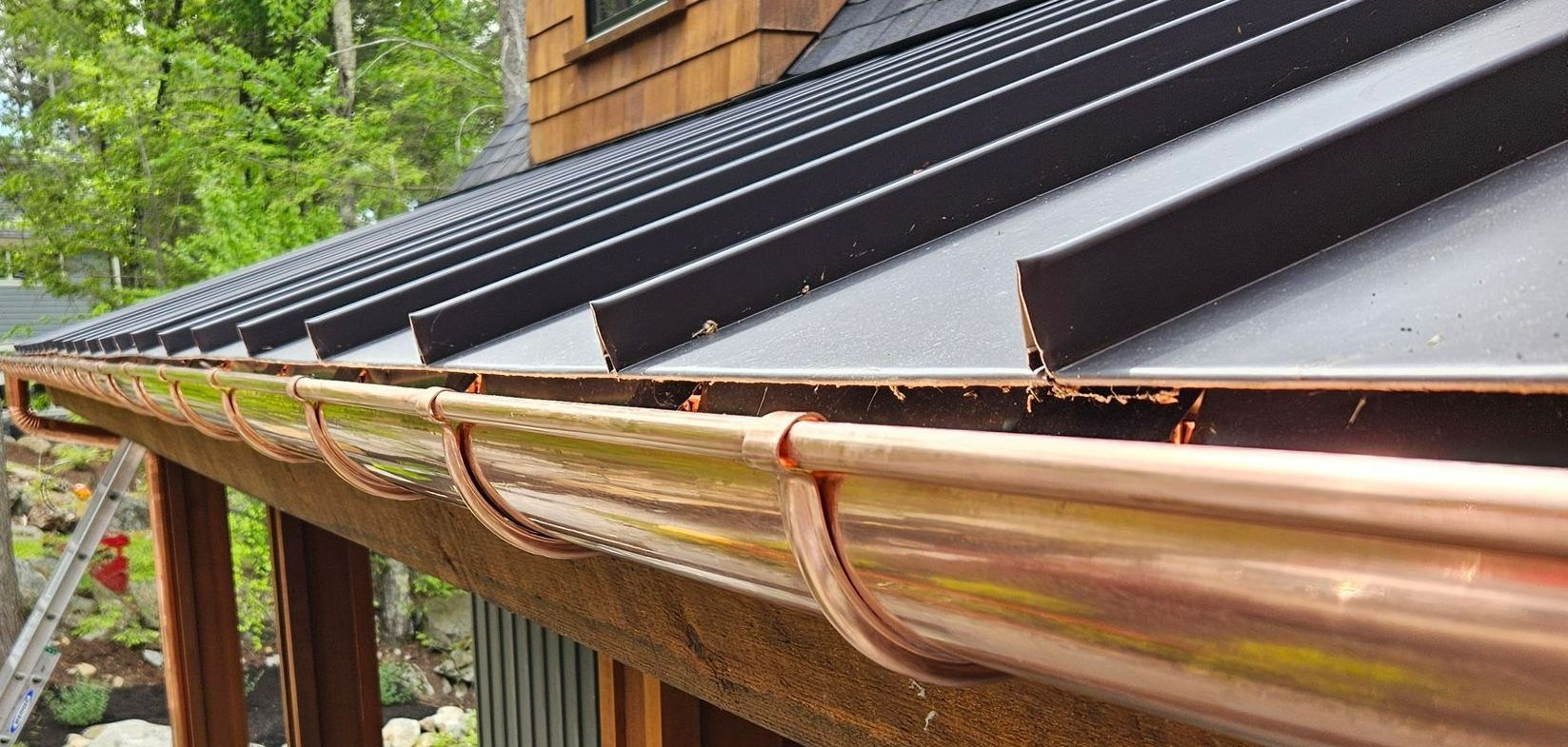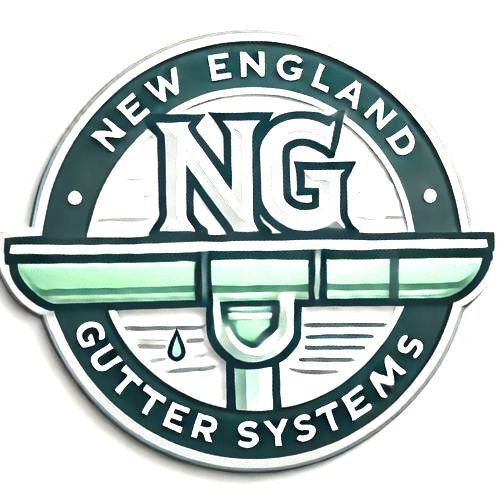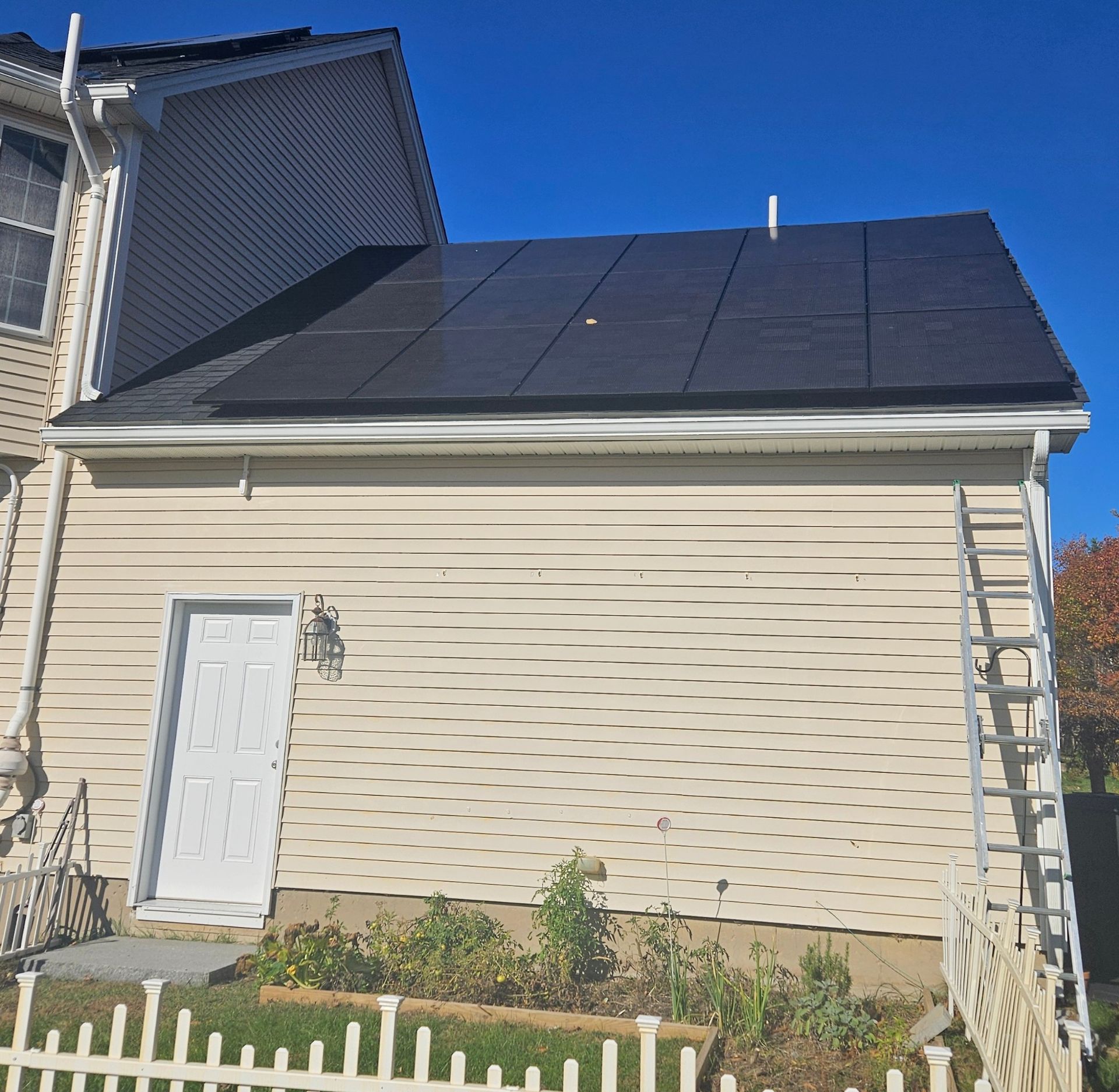Choosing the Right Gutter System for Homes with Solar Panels: Why Larger Gutters are Essential
Homes with Solar Panels Require Specialized Gutter Installations
If your home has solar panels installed, you’re already benefiting from clean energy and savings. But did you know that adding the right gutter system can help protect your home from water damage, especially if your panels extend past the roofline? When solar panels overshoot the roof, rainwater runoff is directed further out, often bypassing standard-sized gutters. This can lead to overflow, soil erosion, and even foundation damage.
In this guide, we’ll break down why larger seamless gutters and specific materials, profiles, and features are crucial for properties with solar panels.
How Solar Panels Affect Rainwater Flow and Gutter Systems
Solar panels increase your roof’s surface area, causing rainwater to run off in greater volume and at higher velocity. When panels extend beyond the roofline, they create additional runoff that standard 5-inch gutters struggle to handle. Here’s where larger gutters, at least 6-inch gutters but more likely custom 7-Inch and 8-Inch sizes, become vital for managing the extra water load and protecting your property.
Why Choose Larger Gutters for Solar Panel Runoff?
Larger gutters capture and manage increased runoff efficiently, preventing issues associated with overshooting panels.
1. Increased Rainfall Volume As rainwater flows off the solar panels, it’s directed away from the roofline in a heavier stream. This added volume can easily overwhelm smaller gutters. Larger gutters, especially 6-inch or custom sizes, are built to handle more water, keeping it from spilling over and causing damage to your landscape and foundation.
2. Extended Catchment Area
When solar panels overshoot the roofline, water lands further out. Larger gutters provide an extended catchment area to intercept this runoff before it bypasses the gutter entirely. Whether you’re in an area with heavy rainfall or seasonal storms, larger gutters keep your system functioning effectively, preventing costly water damage.
3. Handling Intense Rainstorms
With climate patterns shifting, extreme weather events are more common. During heavy rain, overshooting panels produce increased runoff that standard gutters can’t manage. Installing larger gutters offers the extra capacity needed to keep water contained during these storms, reducing the risk of overflow and potential foundation issues.
4. Protection for Foundation and Landscape
Rainwater overshooting smaller gutters can erode soil, damage plants, and even impact your home’s foundation over time. By choosing Larger Gutters: 6-Inch or Custom 7 -Inch or 8-Inch custom Sizes custom-sized options, you safeguard both your landscaping and your home’s structural integrity.
Recommended Gutter Sizes and Downspouts for Solar Panel Runoff
Opt for Larger Gutters: 6-Inch or Custom 7 -Inch or 8-Inch custom Sizes
For homes with solar panels that extend beyond the roofline, Larger Gutters: 6-Inch or Custom 7 -Inch or 8-Inch custom Sizes(compared to the standard 5-inch) are highly recommended. These larger gutters capture more water and reduce the chance of overflow, especially during heavy rainfall. Additionally, our 3x4-inch downspouts made of heavier gauge aluminum can handle larger volumes, allowing for quicker drainage and preventing clogs.
Adjust Downspouts for Better Flow
With larger gutters, consider upgrading to 3x4-inch downspouts instead of the standard 2x3 inches. This adjustment improves drainage speed, which is essential for managing heavy runoff without blockages. Strategic downspout placement also helps channel water away from the foundation, protecting your property.
Choosing the Right Gutter Materials for Longevity and Strength
The right gutter material can make a big difference in how well your system handles runoff from solar panels.
Here are three popular options:
1. Aluminum Gutters: Lightweight and Durable
Seamless Aluminum gutters are lightweight, corrosion-resistant, and can handle high volumes of water. Opt for high-quality aluminum, like our 0.032-inch thickness, for durability without warping. Aluminum gutters are available in seamless designs, which reduce the risk of leaks and ensure smooth water flow. They are also rust-resistant, making them a low-maintenance choice for high-runoff situations.
2. Copper Gutters: A Premium Choice
Copper is one of the most durable gutter materials, known for its longevity and resistance to corrosion. Copper gutters develop a natural patina over time, adding to their aesthetic appeal while protecting the metal. Although more expensive than aluminum, copper gutters are ideal for clients seeking a high-quality, long-lasting option.
3. Steel Gutters: Heavy-Duty Option
Galvanized steel gutters are strong and durable but can rust over time if not maintained properly. Stainless steel options offer greater rust resistance, although they come at a higher price. Given the weight of steel, these gutters require sturdy installation, but they’re highly effective for managing heavy runoff.
Galvanized Steel Gutters: Strength and Durability for High-Impact Use
Galvanized steel gutters offer exceptional strength and durability, making them a practical option for homes with solar panels that increase water runoff. Coated with a layer of zinc to prevent rust, galvanized steel gutters are designed to withstand harsh weather conditions and high-impact runoff from steep roofs or extended solar panels. While galvanized steel may require occasional maintenance to prevent rust over the years, it’s ideal for those seeking a heavy-duty solution that won’t easily dent or warp. With its robust construction, galvanized steel is especially suited for homes commercial buildings in areas prone to intense storms, providing reliable water management and longevity for your gutter system.
Additional Considerations for Optimal Gutter Performance
Seamless vs. Sectional Gutters: Reducing Leaks and Maintenance
When dealing with increased runoff, seamless gutters offer clear advantages over sectional gutters.
Seamless Gutters for Leak Prevention
Seamless gutters are custom-fit to your roofline, reducing the number of joints where leaks commonly develop. For homes with solar panels, this is especially beneficial, as the increased runoff places added stress on the gutter system. Seamless gutters are often made of aluminum, copper, or galvanized steel, making them a top choice for long-term durability.
Selecting the Right Gutter Profile for Your Property
Gutter profiles impact both functionality and appearance. Here’s a look at three popular styles:
K-Style Gutters: High Capacity and Sleek Look
K-style gutters have a flat back and decorative front, making them both functional and visually appealing. Their increased capacity makes them ideal for handling the high runoff volume associated with solar panel installations. K-style gutters are also easy to install against fascia boards, adding convenience to performance.
Half-Round Gutters: Traditional and Aesthetic
Half-round gutters are commonly chosen for historic or rustic properties. However, they have a smaller capacity than K-style gutters, making them less ideal for managing high-volume runoff from solar panels unless they’re customized. For most homes with overshooting panels, K-style gutters are a more practical choice.
Box Gutters: Ideal for High-Volume Runoff from Solar Panels
Box gutters are a great choice for homes with solar panels, especially when panels extend past the roofline and increase runoff. Unlike standard gutters, box gutters are built with a larger, rectangular profile, allowing them to hold significantly more water. This extra capacity is especially beneficial for handling the heavy, outward-directed runoff that solar panels can create. Available in sizes starting at 7- and 8-inch widths and up to 10-Inch, box gutters provide excellent coverage and help prevent overflow by capturing water further from the roof edge. This makes them ideal for homes in areas with frequent heavy rain, as they minimize the risk of water-related issues around the foundation and landscape. Their sleek, integrated look also complements modern architecture, making box gutters a smart choice for both functionality and style.
Beyond size and material, there are a few extra steps you can take to ensure your gutters perform optimally:
Gutter Guards for Debris Prevention
If you’re installing larger gutters, consider adding gutter guards to keep leaves, twigs, and other debris from clogging the system. Gutter guards help maintain smooth water flow, especially crucial for homes with increased runoff from solar panels.
Perforated Aluminum Gutter Guards: Reinforcing Strength and Protection
Adding perforated aluminum gutter guards to your gutter system significantly enhances both strength and performance, especially for homes with high runoff from solar panels. Unlike screen type materials, perorated aluminum gutter guards are exceptionally durable, making them resistant to warping or bending under heavy water flow. The perforated design allows rainwater to flow freely into the gutters while keeping out leaves, pine needles, and debris that could cause clogs. By reinforcing the gutter system with strong, perforated aluminum guards, you create a robust barrier against potential damage, ensuring smooth drainage even in harsh weather. For properties with solar panels that extend beyond the roofline, tour gutter guards add essential durability, minimizing maintenance and providing long-lasting protection for your home.
Downspout Extensions
Adding downspout extensions directs water further from your foundation, which can be particularly helpful when dealing with high-volume runoff. This simple addition protects your landscape and foundation from potential water damage.
Steeper Roofs and the Impact on Gutter Size
Steeper roof pitches add another layer of complexity to water management. A higher pitch not only directs water faster but also increases the volume of runoff, particularly in heavy rain. For homes with steeply pitched roofs combined with solar panels, larger gutters are critical to capturing and directing water efficiently without overflow. To accommodate these needs, we offer up to 8-inch K-style gutters and 7- and 8-inch box gutters. These larger sizes are specifically designed to handle the intense flow from both steep slopes and panel runoff, ensuring your gutter system works seamlessly, even under challenging conditions.
Why Choose Copper Gutters?
Copper gutters offer several advantages, especially for homes with high runoff from solar panels and steep roofs. Here’s why copper could be the best choice:
Exceptional Durability: Copper gutters are among the most durable, withstanding extreme weather without warping or cracking.
Corrosion Resistance: Copper naturally resists corrosion, making it ideal for homes in humid or rainy climates
Natural Aging Process: Over time, copper develops a patina, a greenish layer that not only adds character but also acts as an extra layer of protection.
High Capacity: Copper gutters are available in larger sizes and can easily be custom-fitted, making them ideal for high-volume water flow.
Minimal Maintenance: With high resistance to rust and debris buildup, copper gutters require less maintenance, saving time and costs in the long run.### Why Copper is a More Sustainable Choice Compared to Aluminum
Copper is often considered a more sustainable gutter material than aluminum due to its natural durability, recyclability, and minimal environmental impact over its lifecycle. Here’s how copper outshines aluminum in sustainability:
1. Exceptional Longevity: Copper gutters are incredibly durable, often lasting up to 50 years or more with minimal maintenance. This long lifespan reduces the need for replacements and minimizes resource consumption over time, unlike aluminum gutters, which may need replacing sooner, depending on conditions.
2.100% Recyclable: Copper is fully recyclable without losing quality, which means old or unused copper gutters can be repurposed or melted down and reused. Aluminum is also recyclable, but the recycling process for copper requires less energy, making copper recycling more efficient and less impactful on the environment.
3. Natural Weathering Process: Copper develops a natural patina over time, which protects it from corrosion and eliminates the need for chemical coatings or paints that aluminum often requires. This natural aging reduces the release of pollutants and eliminates the need for recoating, making copper an eco-friendly option over the long term.
4. Low Maintenance and Fewer Replacements: Copper’s resilience means it requires less maintenance than aluminum, which can be susceptible to dents, corrosion, and wear over time. Reduced maintenance means less frequent use of chemicals, cleaning resources, and replacement materials, further contributing to copper’s sustainability.
In essence, copper’s durability, efficient recyclability, and natural resilience make it an eco-friendly choice that supports a sustainable, long-lasting gutter system with a reduced environmental footprint compared to aluminum.
For homes with solar panels, steep pitches, or both, copper gutters in larger K-style or box profiles provide an effective, long-lasting solution for water management.
Water-Saving Systems for Enhanced Sustainability
For homes aiming to boost sustainability, integrating water-saving systems with gutter installations can make a significant impact.
Here are some water-saving solutions that pair well with gutter systems, especially when considering sustainable materials like copper:
1. Rainwater Harvesting Systems: By connecting gutters to a rainwater harvesting tank, you can capture and store rainwater for uses like irrigation, flushing toilets, or even washing vehicles. These systems reduce reliance on municipal water, conserving resources and lowering water bills.
2. Permeable Downspout Extensions: Instead of directing water into storm drains, permeable downspout extensions allow runoff to soak back into the ground. This helps replenish groundwater levels, supports surrounding vegetation, and reduces erosion, particularly beneficial for landscapes around the home.
3. Smart Irrigation Integration: With rainwater-fed irrigation systems, stored water can be directed through a drip or smart irrigation system that waters plants precisely when needed. This setup minimizes water waste and promotes healthier plants by providing natural rainwater rather than treated tap water.
4. Green Roof and Gutter System Pairing: A green roof absorbs a portion of rainwater before it even reaches the gutters, helping to reduce runoff volume. When paired with a high-capacity gutter system, it provides a complete eco-friendly solution, capturing excess water while creating a natural cooling effect for the home.
5. Rain Gardens: Rain gardens are strategically placed plant beds that collect runoff from gutters and downspouts. They are designed to absorb water efficiently, filtering out pollutants while supporting native plants. This reduces runoff, aids in groundwater replenishment, and creates a sustainable landscape feature.
Incorporating these water-saving systems with sustainable materials like copper gutters not only extends eco-friendly practices but also helps conserve water, reduce utility costs, and promote a healthier, more resilient environment around the home.
















